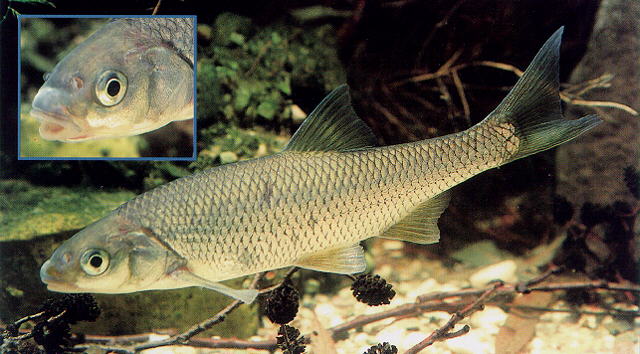| Leuciscidae (Minnows), subfamily: Leuciscinae |
| 40 cm TL (male/unsexed); max.weight: 1,000.0 g; max. reported age: 16 years |
|
benthopelagic; freshwater; brackish; pH range: 6 - 8; depth range - 1 m, potamodromous |
| Europe and Asia: North, Baltic, White and Barents Sea basins; Caspian basin, in Volga and Ural drainages; Black Sea basin, from Danube to Dniepr drainages; Atlantic basin, in Seine drainage; Mediterranean basin from Rhône to Arch drainages (France). Only very localized in Danube main river in Romania, in Scandinavia north of 69°N and most of cenral Finland. Populations from Siberia and East Asia usually referred to Leuciscus leuciscus are distinct species, Leuciscus baicalensis and Leuciscus dzungaricus (Ref. 59043). Has become widespread in Europe and gained access to Ireland as a bait fish. At least one country reports adverse ecological impact after introduction (Ref. 1739). |
|
Dorsal spines (total): 2-3; Dorsal soft rays (total): 7-9; Anal spines: 3-3; Anal soft rays: 8-9; Vertebrae: 42-46. Diagnosed from congeners in Europe by the following characters: subinferior or subterminal mouth; subequal jaw, upper jaw slightly longer; upper lip tip about level with center of eye; not projecting snout; articulation of lower jaw distinctly behind anterior margin of eye; horizontal branch of preoperculum shorter than vertical branch; and 40-50 + 1-2 scales on lateral line (Ref. 59043). Rarely longer than 30 cm TL; normally 47-52 scales in lateral line; anal fin concave; caudal fin forked with 19 rays (Ref. 41616). |
| Gregarious fish which swims near the surface (Ref. 30578). Inhabits moderate to fast-flowing large streams to large rivers with rock or gravel bottom. Adults aggregate in dense swarms in winter in the lower reaches of rivers or backwaters and often migrate to spawning streams in autumn and overwinter there. Juveniles spend winter in cavities along the shores. Early juveniles occur in very shallow shoreline habitats and when they grow, they leave the shores for faster-flowing waters. Feeding larvae thrive along shores. Prey on small invertebrates. Spawns in fast-flowing water on shallow gravel beds, often in small tributaries (Ref. 59043). Breeds in March and April (Ref. 30578). Pale yellow eggs are found attached to gravel and stones in shallow, flowing water (Ref. 41678). |
|
Least Concern (LC); Date assessed: 17 October 2023 Ref. (130435)
|
| potential pest |
Source and more info: www.fishbase.org. For personal, classroom, and other internal use only. Not for publication.
